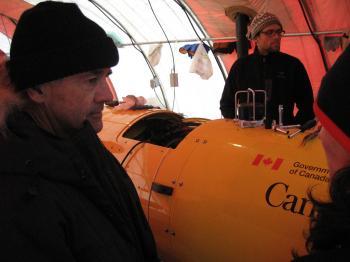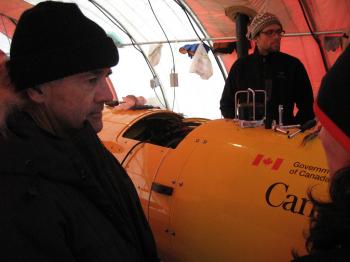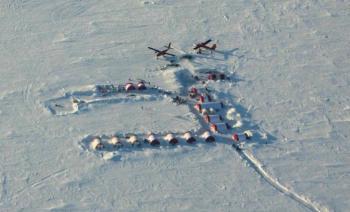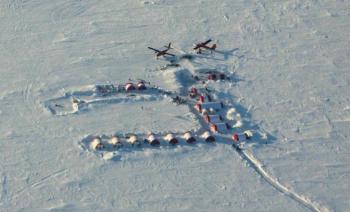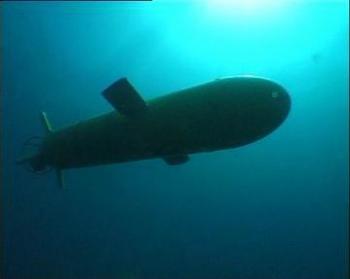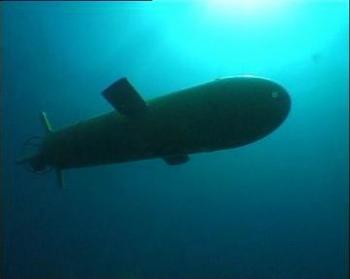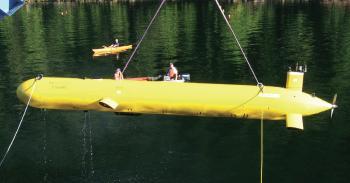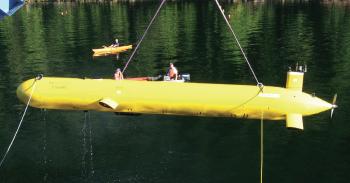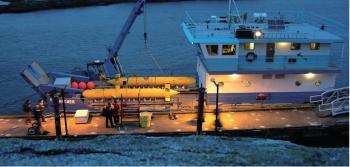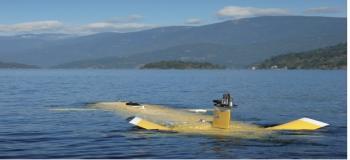OTTAWA—Foreign Affairs Minister Lawrence Cannon visited the Far North this Monday and Tuesday to see firsthand the work of scientists who are mapping the seabed and collecting data to help establish Canada’s Arctic sovereignty.
Mr. Cannon’s trip took him to Resolute Bay in Nunavut, a meeting and launching base for Arctic research and expeditions, and to Borden Island where researchers at an ice camp are conducting fieldwork as part of the effort to determine the outer limits of Canada’s continental shelf.
“At some point, there will be another line on the map of Canada showing the outer limits of the extended continental shelf. The staff of the Borden Island camp are among those who will have helped to put that new line on the map,” Mr. Cannon said in a statement.
His arrival on Monday also marked the first dive in the Arctic of the Explorer, a Canadian-made autonomous underwater vehicle (AUV) equipped with state-of-the-art sonar technology for Arctic research and mapping.
Canada is the first country to use this type of mini robotic submarine to operate under ice in Arctic waters. The federal government acquired two Explorers last year specifically to support the northern mapping effort.
The dive from the Borden Island camp took about two hours, three or four kilometres out and then back, which is a standard first deployment when a new mission begins, said James Ferguson, vice president of Port Coquitlam, B.C.-based International Submarine Engineering Ltd. (ISE) that built the AUVs.
“Over the next few days we’ll be working to understand the environment that the vehicles are operating in over longer distances,” said Mr. Ferguson, noting that six or seven ISE engineers are in the Arctic helping Natural Resources Canada (NRCan) staff operate the AUVs.
ISE has been building AUVs since the mid-1980s. Mr. Ferguson said a typical mission will see an AUV programmed to travel 175 to 200 kilometres to reach the survey location. It may then do a 50-kilometre survey before returning to the starting point.
“As it approaches the end of a mission, we use a noise-source acoustic beacon that it homes in on so that we get it back to the point of recovery.”
The bright yellow torpedo-shaped Explorer is 7.4 metres long and weighs 2,200 kilograms. Powered by rechargeable lithium-ion batteries like the kind used in laptops, cell phones, and other portable electronics, the AUV has a range of some 450 kilometres and can travel to a depth of 5,000 metres, or 17,000 feet, Mr. Ferguson said.
The Borden Island mission is to support Canada’s land claim under the United Nations Convention on the Law of the Sea (UNCLOS). The law outlines the range of sovereign rights that a country has in its internal waters and in various maritime zones depending on the distance from shore, such as rights over research, protection, exploration, and fisheries and other resources.
The UNCLOS recognizes a country’s sovereignty up to 200 nautical miles (370 kilometres) from its coastline. However, a country can claim sovereignty beyond this limit, up to 350 nautical miles (648 kilometres) from shore, if it can prove that its continental shelf extends that far as a natural extension of its land territory.
Canada ratified the UNCLOS treaty in 2003 and has until 2013 to prepare evidence and submit a claim to the U.N. Commission on the Limits of the Continental Shelf.
“The AUV has now completed three test surveys around the ice camp and has performed perfectly,” said Dr. Jacob Verhoef, director of NRCan’s UNCLOS Program, by email from the High Arctic on Wednesday. “We are planning one more test survey and then will send the AUV to the offshore camp, which is about 300 kilometres from the main camp.”
To launch the AUV into the water requires cutting a hole through the ice and removing 30 tonnes of ice. It was not difficult to find a suitable location to cut the hole at the main camp, about 5 kilometres south of Borden Island, Dr. Verhoef said. However, he noted that it was much harder to find a location for the offshore camp. Researchers started monitoring ice floes in early January to find a suitable location.
“One of the challenges unique in the Arctic is that in many of the places we need to survey, the ice is moving,” said Mr. Ferguson. After an AUV is deployed from a location on an ice floe, it may take three or four days to complete the survey. Meanwhile, the floating piece of ice may have moved as much as 40 kilometres.
“That presents somewhat of a risk in recovery. That means we have to have a much more powerful beacon for the vehicle to home in on,” he said.
“Presently the drifts are small, three to five kilometres per day. However, this could change with significant wind events,” said Dr. Verhoef, noting that currently the weather conditions are good at the main camp, with clear skies, light wind, and a temperature of -25 degrees centigrade.
“However, this can change quickly and we cannot say how many weather delays we will have.”
Dr. Verhoef’s team is collecting and analyzing data along the entire Canadian Archipelago, about 1,200 kilometres east to west. After several years focused on the eastern Arctic, it is now looking west, starting with the Borden Island mission which is expected to continue through the spring of 2010. The island mostly belongs to the Northwest Territories but its easternmost section belongs to Nunavut.
“Our data is widely spaced, along profiles several tens of kilometres apart. We have now completed over 70 percent of the [total] data collection and hope to add more to it during this survey and the next survey in the fall of 2010, jointly with the U.S., which will collect more data in the western Arctic,” said Dr. Verhoef.
In addition to drifting ice, “another risk is that the bottom we’re surveying is unknown,” Mr. Ferguson said. “The vehicle may encounter obstacles which it can’t possibly avoid in time,” such as an underwater cliff.
But “there’s an advantage [in the Arctic] because there’s not a lot of sea life living under ice, and no shipping, so it’s acoustically very quiet. The acoustic sensors and communication systems we use work over a much longer range underneath the ice than they do over an open ocean.”
The acoustic sensors used to collect the survey data is manufactured by Perth, Ontario-based Knudsen Engineering Limited near Ottawa, which has produced sonar systems for Arctic survey mapping since the 1980s.
NRCan, Fisheries and Oceans Canada, Defence Research and Development Canada, and Environment Canada are collaborating on the scientific and other support work related to Canada’s submission to the U.N. commission in December 2013. Foreign Affairs and International Trade Canada has overall responsibility for preparing and presenting the submission.
“We are on track for a strong submission by our deadline in 2013,” Dr. Verhoef said.
Mr. Cannon’s trip took him to Resolute Bay in Nunavut, a meeting and launching base for Arctic research and expeditions, and to Borden Island where researchers at an ice camp are conducting fieldwork as part of the effort to determine the outer limits of Canada’s continental shelf.
“At some point, there will be another line on the map of Canada showing the outer limits of the extended continental shelf. The staff of the Borden Island camp are among those who will have helped to put that new line on the map,” Mr. Cannon said in a statement.
His arrival on Monday also marked the first dive in the Arctic of the Explorer, a Canadian-made autonomous underwater vehicle (AUV) equipped with state-of-the-art sonar technology for Arctic research and mapping.
Canada is the first country to use this type of mini robotic submarine to operate under ice in Arctic waters. The federal government acquired two Explorers last year specifically to support the northern mapping effort.
The dive from the Borden Island camp took about two hours, three or four kilometres out and then back, which is a standard first deployment when a new mission begins, said James Ferguson, vice president of Port Coquitlam, B.C.-based International Submarine Engineering Ltd. (ISE) that built the AUVs.
“Over the next few days we’ll be working to understand the environment that the vehicles are operating in over longer distances,” said Mr. Ferguson, noting that six or seven ISE engineers are in the Arctic helping Natural Resources Canada (NRCan) staff operate the AUVs.
ISE has been building AUVs since the mid-1980s. Mr. Ferguson said a typical mission will see an AUV programmed to travel 175 to 200 kilometres to reach the survey location. It may then do a 50-kilometre survey before returning to the starting point.
“As it approaches the end of a mission, we use a noise-source acoustic beacon that it homes in on so that we get it back to the point of recovery.”
The bright yellow torpedo-shaped Explorer is 7.4 metres long and weighs 2,200 kilograms. Powered by rechargeable lithium-ion batteries like the kind used in laptops, cell phones, and other portable electronics, the AUV has a range of some 450 kilometres and can travel to a depth of 5,000 metres, or 17,000 feet, Mr. Ferguson said.
The Borden Island mission is to support Canada’s land claim under the United Nations Convention on the Law of the Sea (UNCLOS). The law outlines the range of sovereign rights that a country has in its internal waters and in various maritime zones depending on the distance from shore, such as rights over research, protection, exploration, and fisheries and other resources.
The UNCLOS recognizes a country’s sovereignty up to 200 nautical miles (370 kilometres) from its coastline. However, a country can claim sovereignty beyond this limit, up to 350 nautical miles (648 kilometres) from shore, if it can prove that its continental shelf extends that far as a natural extension of its land territory.
Canada ratified the UNCLOS treaty in 2003 and has until 2013 to prepare evidence and submit a claim to the U.N. Commission on the Limits of the Continental Shelf.
“The AUV has now completed three test surveys around the ice camp and has performed perfectly,” said Dr. Jacob Verhoef, director of NRCan’s UNCLOS Program, by email from the High Arctic on Wednesday. “We are planning one more test survey and then will send the AUV to the offshore camp, which is about 300 kilometres from the main camp.”
To launch the AUV into the water requires cutting a hole through the ice and removing 30 tonnes of ice. It was not difficult to find a suitable location to cut the hole at the main camp, about 5 kilometres south of Borden Island, Dr. Verhoef said. However, he noted that it was much harder to find a location for the offshore camp. Researchers started monitoring ice floes in early January to find a suitable location.
“One of the challenges unique in the Arctic is that in many of the places we need to survey, the ice is moving,” said Mr. Ferguson. After an AUV is deployed from a location on an ice floe, it may take three or four days to complete the survey. Meanwhile, the floating piece of ice may have moved as much as 40 kilometres.
“That presents somewhat of a risk in recovery. That means we have to have a much more powerful beacon for the vehicle to home in on,” he said.
“Presently the drifts are small, three to five kilometres per day. However, this could change with significant wind events,” said Dr. Verhoef, noting that currently the weather conditions are good at the main camp, with clear skies, light wind, and a temperature of -25 degrees centigrade.
“However, this can change quickly and we cannot say how many weather delays we will have.”
Dr. Verhoef’s team is collecting and analyzing data along the entire Canadian Archipelago, about 1,200 kilometres east to west. After several years focused on the eastern Arctic, it is now looking west, starting with the Borden Island mission which is expected to continue through the spring of 2010. The island mostly belongs to the Northwest Territories but its easternmost section belongs to Nunavut.
“Our data is widely spaced, along profiles several tens of kilometres apart. We have now completed over 70 percent of the [total] data collection and hope to add more to it during this survey and the next survey in the fall of 2010, jointly with the U.S., which will collect more data in the western Arctic,” said Dr. Verhoef.
In addition to drifting ice, “another risk is that the bottom we’re surveying is unknown,” Mr. Ferguson said. “The vehicle may encounter obstacles which it can’t possibly avoid in time,” such as an underwater cliff.
But “there’s an advantage [in the Arctic] because there’s not a lot of sea life living under ice, and no shipping, so it’s acoustically very quiet. The acoustic sensors and communication systems we use work over a much longer range underneath the ice than they do over an open ocean.”
The acoustic sensors used to collect the survey data is manufactured by Perth, Ontario-based Knudsen Engineering Limited near Ottawa, which has produced sonar systems for Arctic survey mapping since the 1980s.
NRCan, Fisheries and Oceans Canada, Defence Research and Development Canada, and Environment Canada are collaborating on the scientific and other support work related to Canada’s submission to the U.N. commission in December 2013. Foreign Affairs and International Trade Canada has overall responsibility for preparing and presenting the submission.
“We are on track for a strong submission by our deadline in 2013,” Dr. Verhoef said.
“The work I saw being carried out at the ice camp is essential to Canada’s continental shelf submission,” said Minister Cannon. “This submission is a priority for our government as we protect and defend Canada’s interests in the North.”


